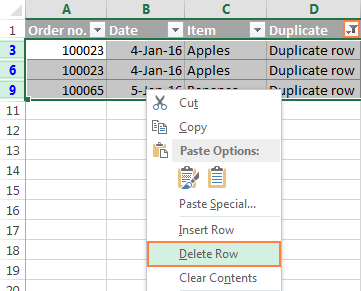

Selecting this check box would remove the header row from the selection.

If your data has headers, you can use the check box titled “My Data has headers”. The button Unselect All will unselect all columns from the selected range. As the name implies, the Select All button selects all columns from the selected range. The first button is ‘Select All’ and the other button is ‘Unselect All’. In order to do that, you have two buttons. To remove duplicate values, you must select one or more columns that contain duplicate values. Step 3 : You will now see the Remove Duplicates Wizard. Step 2: On the Excel ribbon, Click Data and then select Remove Duplicates Step 1: Select the range from which duplicate records must be removed This column will be considered as the Primary key field. So, the first step is to identify columns that should have unique values. This is the only method that allows you to remove duplicates excel based on certain columns. This option helps you to remove duplicates from a huge dataset.
#Excel find duplicates but do not delete how to
Level of difficulty: LOW How To Delete Duplicates In Excel: Option 1: Remove Duplicates Excel So, what is the ultimate solution to it? You need to delete duplicates in excel spreadsheet for accurate final reports. This step is crucial, failure to do so will result in wrong data representations in your reports.

All duplicate records must be deleted from the spreadsheet. You can add individual values, cell references or ranges in excel.When you are collating spreadsheets from several other spreadsheets, there are higher chances that the final master spreadsheet will have duplicate records. The Excel SUM function will adds all numbers in a range of cells and returns the sum of these values. The IF function is a build-in function in Microsoft Excel and it is categorized as a Logical Function.The syntax of the IF function is as below:= IF (condition,, )…. The Excel IF function perform a logical test to return one value if the condition is TRUE and return another value if the condition is FALSE. The Excel MATCH function search a value in an array and returns the position of that item.The syntax of the MATCH function is as below:= MATCH (lookup_value, lookup_array, )… The Excel ROW function returns the row number of a cell reference.The ROW function is a build-in function in Microsoft Excel and it is categorized as a Lookup and Reference Function.The syntax of the ROW function is as below:= ROW ()…. This function can be used to count the different kinds of cells with number, date, text values, blank, non-blanks, or containing specific characters.etc.= COUNTIF (range, criteria)… The Excel COUNTIF function will count the number of cells in a range that meet a given criteria. The Excel SUMPRODUCT function multiplies corresponding components in the given one or more arrays or ranges, and returns the sum of those products.The syntax of the SUMPRODUCT function is as below: = SUMPRODUCT (array1,…)… We can check the result is 3 (Product D\E\F are unique values and only appeared in one season). Step2: Click Enter and get the result in E2. Step 1: In E2 which is saved the total product type number, enter the formula “ = SUM( IF(FREQUENCY( MATCH(B1:B11,B1:B11,0), ROW(B1:B11)-ROW(B1)+1)=1,1))”, B1:B11 is the range you want to count the unique values. Count Unique Values Excluding All Duplicates by Formula in Excel In above sample, we do count for unique values and get the result 6, because we have six products A\B\C\D\E\F, and if we want to only count the unique values exclude all duplicates like product A\B\C (they appeared more than one season) how can we do count? See below steps. We can check the result is 6, and the duplicates are not included. Step 2: Click Enter and get the result in E2. B1:B11 is the range you want to count the unique values. Step 1: In E2 which is saved the total product type number, enter the formula “ = SUMPRODUCT(1/ COUNTIF(B1:B11,B1:B11))”. Count Unique Values Excluding Duplicates by Formula in Excel If we just use sum formula to do count, then duplicates will be included, so we need another formula to do count excludes the duplicates. And we want to count the total product type in one year, how can we do count?


 0 kommentar(er)
0 kommentar(er)
